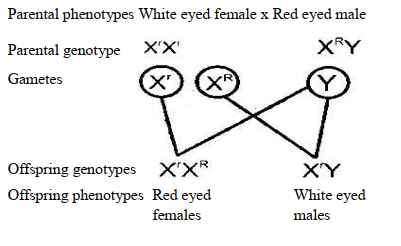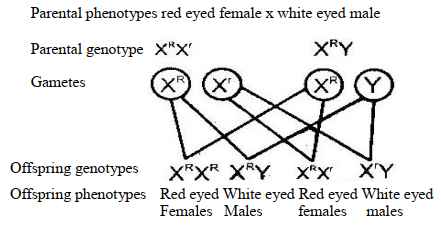Questions
- The figure below is a structural diagram of a portion from a nucleic acid strand.

- Giving a reason, name the nucleic acid to which the portion belongs. (2 marks)
Name _________________________
Reason ________________________ - Write down the sequence of bases of a complimentary strand to that shown above (1 mark)
- Giving a reason, name the nucleic acid to which the portion belongs. (2 marks)
- State two structural differences between ribonucleic acid ( RNA) and deoxyribonucleic acid ( DNA) (2 marks)
- Name a disorder of human blood that is caused by mutation (1 mark)
- State the function of deoxyribonucleic acid (DNA) molecule (1 mark)
- Give a reason why it is only mutation in genes of gametes that influence evolution ( 2 marks)
- In an experiment, red flower were crossed with plants with white flower. All the plants in the F1 generation had pink flowers.
- (Give a reason for the appearance of pink flower in the F1 generation ( 1 mark)
- If the plants from F1 generation were selfed, state the phenotype ratio of the F2 generation ( 2 marks)
- State two characteristics that researchers select in breading programmes. (2 marks)
- Give an example of sex- linked trait in humans on; ( 2 marks)
Y chromosome __________________
X chromosome __________________ - In an experiment, a variety of garden peas having a smooth seed oat was crossed with a variety with a wrinkled seed coat. All the seeds obtained in the F1 had a smooth seed coat. The F1 generation was selfed. The total number of F2 generation was 7324.
- Using appropriate letter symbols, work out the genotype of the F1 generation. ( 4 marks)
- From the information above, work out the following for the F2 generation
- Genotype ratio ( 2 marks)
- Phenotype ratio ( 1 mark)
- Wrinkled number ( 1 mark)
- In a certain plant species, some individual plant may have white, red or pink flower. In an experiment a plant with white parent plant were pure lines. All the plants from F1 generation were pink. Using letter R to represent the gene for red colour and letter W for white colour;
- Work out the genotype of F1 generation ( 3 marks)
- If the plants from F1 generation were selfed, what would be the phenotypic ratio of the F2 generation? ( 3 marks)
- What is the genetic explanation for the absence of plants with red and white in the flower F1 generation? ( 2 marks)
- In a breeding experiment, plants with red flower were crossed. They produced 123 plants with red flowers and 41 with white flowers.
- Identify the recessive character. Give a reason
- What were the genotypes of the parent plants that give rise to the plants with red and white flowers?
- If the white flowers were selfed, what would be the genotypes of their offspring?
-
- Name two disorders in humans caused by gene mutation (2 marks)
- Describe the following chromosomal mutations
- Inversion ( 2 marks)
- Translocation
- In mice the allele for black fur is dominant to the allele for brown fur. What percentage offspring would have brown fur from a cross between heterozygous black mice and brown mice? Show your working. Use letter B to represent the allele for black colour. (4 marks)
-
- What is meant by the term allele? ( 1 mark)
- Explain how the following occur during gene mutation
- Deletion ( 1 mark)
- Inversion ( 1 mark)
- What is a test- cross? ( 1 mark)
- In maize the gene for purple colour is dominant to the gene for white colour. A pure breeding maize plant with purple grains was crossed with a heterozygous plant.
-
- Using letter G to represent the gene for purple colour, work out the genotypic ratio of the offspring ( 5 marks)
- State the phenotype of the offspring ( 1 mark)
- What is genetic engineering? ( 1 mark)
-
- Define the following terms as used in genetics.
- Alleles
- Genotype
- Phenotype
- A farmer mated his dark red cow with a white bull. The cow gave birth to a light red calf
- State why the calf is light red and not dark red or white
- If a light red bull is mated with a dark red cow, work out using appropriate letter symbols the probability of getting a light offspring
- What is meant by linked genes?
-
- In fruit flies (Drosophila) the gene for red eyes ® is dominant over the one for white – eye (r). If a true breeding white – eyed male, all the offspring will be red eyed. However, if a true – breeding whiteeyed female is mated with a true- breeding red- eyed male, all the female offspring will be red – eyed. Explain this apparent contradiction.
- Work out the ratio of the expected phenotypes if a red- eyed female offspring from the cross- described in (i) above is mated with red- eyed males.
-
- Explain the term variation with reference to the study of genetics.
- Using relevant examples distinguish between discontinuous variation and continuous variation
- What is the importance of genetic variation?
- Describe one example where genetic variations has helped a species to survive
- The diagram below shows the base sequence of part of a nucleic acid stand. Observe it and answer the questions that follow
G T T A G C T G A- What do the letters G, T , C and A represent?
- Giving your reasons state whether it is part of DNA or an RNA strand.
- Show the complementary DNA strand
- Show the complimentary RNA strand
- In human couples the sex of a baby is determined by the man. Explain this statement.
Answers
-
- - Ribonucleic acid
- Has the base ‘U’ uracil - -G- C –A – G
- - Ribonucleic acid
RNA DNA Has ribose sugar Deoxyribose sugar Has uracil as one Has thyamine of its bases Single strand Double strand - Haemophilia (sickle cell anaemia)
- Controls / regulates enzyme / synthesis for the material for inheritance.
- Gametes form new offspring
- Co-dominance / incomplete dominance
- - High yielding Hybrid vigour
- Resistance to disease, early maturity.
- Resistance to drought early maturity. - Y Chromosome – Hairy pinna, tuft and hair sprouting from the pinna, baldness.
X Chromosome – Colour blindness; Haemophilia -
- Smooth seed coat is dominant to wrinkled seed coat. Let R represent gene for smooth and parental genotype RR x rr
r r R Rr Rr R Rr Rr
All F1 are ………………….Rr -
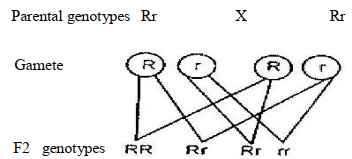
- Genotypic ratio 1RR : 2Rr: 1rr
- Phenotype ratio 3 smooth: 1 wrinkled
- Wrinkled number ¼ x 7324 = 1831
- Smooth seed coat is dominant to wrinkled seed coat. Let R represent gene for smooth and parental genotype RR x rr
-
-
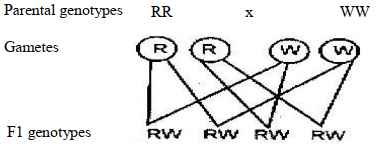
- 1:2:1 for ratio, 1 white: 2 pink: 1 red
- Co-dominance / incomplete dominance / partial dominance / equal dominance.
-
-
- White
- Fewer number / lower rates / absence of white in parent and its presence in offspring. - Heterozygous/ Rr
- Homozygous / rr / double recessive.
- White
-
-
- Haemophilia
- Sickle cell anaemia
- Colour blindness
- Leukemia
- Albinism
-
- Inversion- A result of a chromosomal break up and rejoining with the middle piece turned by 1800
- Translocation- A section of chromosome breaking and joining a homologous chromosome.
- Phenotype: Black mice x Brown mice
Genotype Bb x bb
Gametes B b b b
F1 genotype Bb Bb bb bb
Phenotype 2 black : 2 brown
-
-
- It is alternative form of a chromosome been similar in structure but may have different composition.
- Occurs when the nucleotides of a gene break off and disappear
- Occurs when the nucleotides of a part of a gene become inverted by taking a 1800 turn.
- Testing the genotype of an individual by crossing with the recessive trait.
-
-
-
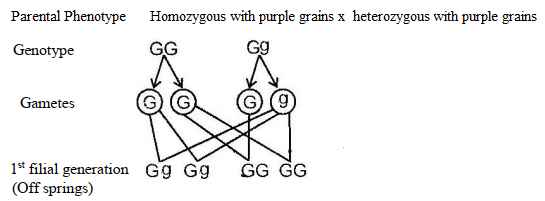
- The genotype ratio: 1:1
- 2 homozygous purple coloured grains
- 2 heterozygous purple coloured grains - All purple coloured grained maize plants maize plants.
-
- Deliberate modification of a characteristics are of an organism by manipulates genes and DNA by transferring genes from one organism to another.
- It is when best characteristics are developed from both parents and offspring better than either parent.
-
-
- Alleles are alternative forms of the same gene which control the inheritance of contrasting features of the same position in homologous chromosomes.
- Genotype is the genetic makeup or composition of an organism.
- Phenotype is the outward appearance of an organism with reference to a particular trait.
-
- The genes for dark red colour and white colour are co-dominant. Since the calf is heterozygous it gets a coat colour that is intermediate between dark red and white
- Let R represent the gene for dark red coat colour and W the gene for white coat colour. The light red bull must be heterozygous (RW) and the dark red cow must be homozygous (RR)
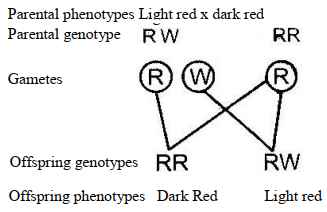
-
- Linked genes are those genes that are found in the same chromosomes. They are usually inherited together.
- These observation show that eye colour in fruit flies is a sex-linked trait. Since it is well known that the Y chromosomes carries very few genes, we can assume that eye colour in fruit flies is an x-linked trait.
- When a true-breeding, red-eyed female is mated with a white-eyed male, all the offspring received an X-chromosome carrying the dominant gene from the mother. Because of this, they all develop red eyed. This is illustrated below.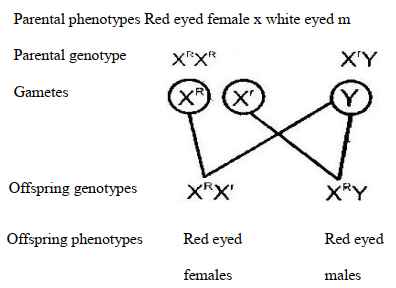
When a true breeding white eyed female is mated with a red-eyed male, the female offspring receive an X-chromosome carrying the dominant gene from the father and develop red eyed. The male offspring received an X-chromosome carrying the recessive gene from the mother. They also receive a Y chromosome contains no genes for eye colour the male offspring develop white eyes. -
-
- Variation refers to the difference in specific characteristics that exist between members of a species e.g. in humans, characteristics that exist between members of a species e.g. in human, characteristics such as height, blood group.
- Discontinuous variation refers to the existence of two or more distinct forms between them e.g. pink or white flowers in pea plants
- Continuous variation refers to the existence of a characteristic in a continuous gradation between two extremes e.g. height, weight and fruit size in trees. - Genetic variation provides the raw materials for evolution by natural selection.
It increases the chances of survival in an ever-changing environment. If a particular species is highly adapted to a specific habitat, it might find it difficult to survive in case there is a sudden change in the environmental conditions. In absence of variation, such a change may lead to death of all members have a variation that adapts them to the new conditions they will survive. They will reproduce and multiply rapidly in the absence of competition from other forms.
Since the variation is genetic, the adaptation is passed on to subsequent generations. - When DDT was first used in the 1950’s it was very effective in killing mosquitoes. In areas where mosquito populations were previously large, their numbers were greatly reduced. However, in the 1960’s the number of mosquitoes in these areas began to rise again despite the continued application of DDT.
- It then became evident that a few mutant forms had a variation that made them resistant to DDT. In the absence of competition from other forms, the resistant forms reproduced and multiplied very fast. The result was that the number of mosquitoes started to arise again despite the continued application of DDT.
- Thus the presence of a variation in the few mutant forms saved mosquitoes from extinction.
-
- They represent the bases guamine, thymine, cytosine, adenine
- It is a DNA strand because it contains the base thymine which is absent in RNA.
- C A A T C G A C T
- C A A T C G A C U
- Human females produce one type of egg containing an X chromosome. Males produce two types of sperms; half contains a X-chromosome and the other half contains a Y chromosome.
Fertilization of the egg by a sperm carrying an X chromosome gives rise to a baby girl.
Fertilization of the egg by a sperm carrying a Y-chromosome gives rise to a baby boy.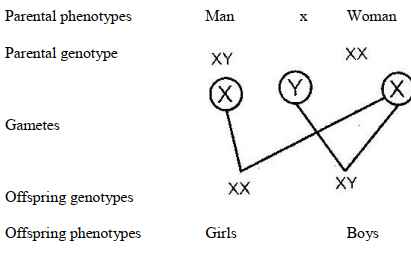
Join our whatsapp group for latest updates
Tap Here to Download for 50/-
Get on WhatsApp for 50/-
Download Genetics Questions and Answers - Biology Form 4 Topical Revision.
Tap Here to Download for 50/-
Get on WhatsApp for 50/-
Why download?
- ✔ To read offline at any time.
- ✔ To Print at your convenience
- ✔ Share Easily with Friends / Students

